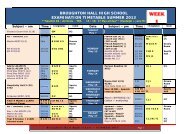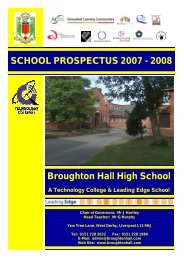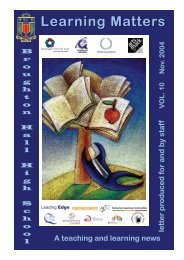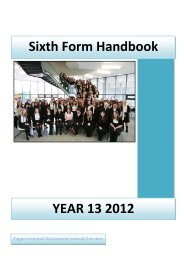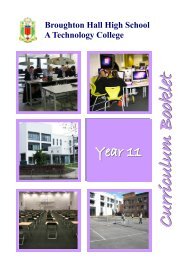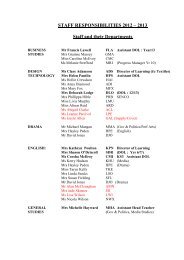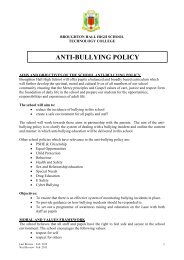OFSTED Report 2012 - Broughton Hall High School
OFSTED Report 2012 - Broughton Hall High School
OFSTED Report 2012 - Broughton Hall High School
Create successful ePaper yourself
Turn your PDF publications into a flip-book with our unique Google optimized e-Paper software.
<strong>Broughton</strong> <strong>Hall</strong> <strong>High</strong> <strong>School</strong>, A<br />
Technology College<br />
Inspection report<br />
Unique Reference Number 104713<br />
Local authority<br />
Liverpool<br />
Inspection number 377116<br />
Inspection dates 11–12 January <strong>2012</strong><br />
Lead inspector<br />
Sally Kenyon HMI<br />
This inspection of the school was carried out under section 5 of the Education Act 2005.<br />
Type of school<br />
Secondary<br />
<strong>School</strong> category<br />
Voluntary aided<br />
Age range of pupils 11–18<br />
Gender of pupils<br />
Girls<br />
Gender of pupils in the sixth form<br />
Girls<br />
Number of pupils on the school roll 1,300<br />
Of which number on roll in the sixth form 220<br />
Appropriate authority<br />
The governing body<br />
Chair<br />
Joe Hartley<br />
Headteacher<br />
Gerard Murphy<br />
Date of previous school inspection 18 April 2007<br />
<strong>School</strong> address<br />
Yew Tree Lane<br />
West Derby<br />
Liverpool<br />
L12 9HJ<br />
Telephone number 0151 235 1500<br />
Fax number 0151 259 8448<br />
Email address<br />
murphygm@broughtonhall.com<br />
Age group 11–18<br />
Inspection date(s) 11–12 January <strong>2012</strong><br />
Inspection number 377116
Inspection report: <strong>Broughton</strong> <strong>Hall</strong> <strong>High</strong> <strong>School</strong>, A Technology College, 11–12 January <strong>2012</strong> 2of 12<br />
You can use Parent View to give Ofsted your opinion on your child's school.<br />
Ofsted will use the information parents and carers provide when deciding which<br />
schools to inspect and when.<br />
You can also use Parent View to find out what other parents and carers think<br />
about schools in England. You can visit www.parentview.ofsted.gov.uk, or look<br />
for the link on the main Ofsted website: www.ofsted.gov.uk<br />
The Office for Standards in Education, Children's Services and Skills (Ofsted) regulates and inspects to<br />
achieve excellence in the care of children and young people, and in education and skills for learners of<br />
all ages. It regulates and inspects childcare and children's social care, and inspects the Children and<br />
Family Court Advisory Support Service (Cafcass), schools, colleges, initial teacher training, work-based<br />
learning and skills training, adult and community learning, and education and training in prisons and<br />
other secure establishments. It assesses council children's services, and inspects services for looked<br />
after children, safeguarding and child protection.<br />
Further copies of this report are obtainable from the school. Under the Education Act 2005, the school<br />
must provide a copy of this report free of charge to certain categories of people. A charge not<br />
exceeding the full cost of reproduction may be made for any other copies supplied.<br />
If you would like a copy of this document in a different format, such as large print or Braille, please<br />
telephone 0300 123 4234, or email enquiries@ofsted.gov.uk<br />
You may copy all or parts of this document for non-commercial purposes, as long as you give details<br />
of the source and date of publication and do not alter the information in any way.<br />
To receive regular email alerts about new publications, including survey reports and school inspection<br />
reports, please visit our website and go to 'Subscribe'.<br />
Piccadilly Gate<br />
Store Street<br />
Manchester M1 2WD<br />
T: 0300 123 4234<br />
Textphone: 0161 618 8524<br />
enquiries@ofsted.gov.uk<br />
www.ofsted.gov.uk<br />
© Crown copyright <strong>2012</strong>
Inspection report: <strong>Broughton</strong> <strong>Hall</strong> <strong>High</strong> <strong>School</strong>, A Technology College, 11–12 January <strong>2012</strong> 3of 12<br />
Introduction<br />
Inspection team<br />
Sally Kenyon<br />
Alan Parkinson<br />
Kathleen Harris<br />
Michael Cooper<br />
Bernard Robinson<br />
Her Majesty's Inspector<br />
Additional inspector<br />
Additional inspector<br />
Additional inspector<br />
Additional inspector<br />
This inspection was carried out with two days' notice. Inspectors observed 38<br />
teachers in 41 lessons and conducted four learning walks. Meetings were held with<br />
leaders at all levels, members of the governing body, staff and students. Inspectors<br />
took account of the responses to the on-line questionnaire (Parent View) in planning<br />
the inspection, 496 responses from parent questionnaires, observed the school's<br />
work, scrutinised students’ books and other documentation.<br />
Information about the school<br />
<strong>Broughton</strong> <strong>Hall</strong> is a larger than average secondary school. The proportion of students<br />
known to be eligible for free school meals is above the national average. The<br />
proportions of students who speak English as an additional language or from<br />
minority ethnic groups are both well below average. The proportion of students with<br />
special educational needs at ‘school action’ is just below average and that of those<br />
with a statement of special educational needs is well below average. There is a ‘soft<br />
federation’ through the sixth form with Cardinal Heenan Boys’ school. The school<br />
moved to a partial new build in April 2011. A convent is on the same site as the<br />
school. The school has met the government floor standards for the past three years<br />
in English. Floor standards were met for the past three years in English and<br />
mathematics.
Inspection report: <strong>Broughton</strong> <strong>Hall</strong> <strong>High</strong> <strong>School</strong>, A Technology College, 11–12 January <strong>2012</strong> 4of 12<br />
Inspection grades: 1 is outstanding, 2 is good, 3 is satisfactory and 4 is inadequate<br />
Please turn to the glossary for a description of the grades and inspection terms<br />
Inspection judgements<br />
Overall Effectiveness 3<br />
Achievement of pupils 3<br />
Quality of teaching 3<br />
Behaviour and safety of pupils 2<br />
Leadership and management 3<br />
Key Findings<br />
<br />
<br />
<br />
<br />
<br />
<br />
<br />
<br />
<br />
<strong>Broughton</strong> <strong>Hall</strong> <strong>High</strong> <strong>School</strong>, a Technology College is a satisfactory school. The<br />
sixth form is also satisfactory.<br />
Achievement is satisfactory rather than good because teaching does not always<br />
meet the needs of all students effectively.<br />
Where good teaching was seen, it was characterised by well planned activities<br />
supported by a good pace, clear learning objectives and outcomes and regular<br />
and accurate assessment.<br />
Where teaching was satisfactory or inadequate, lessons were slow to start,<br />
there was insufficient pace to learning and data about students’ abilities were<br />
not used effectively in the planning or delivery of the lesson. Thus, students of<br />
all abilities, but particularly the most-able, failed to make good progress. This<br />
was most evident at Key Stage 3.<br />
The use of assessment, particularly written feedback is variable. Some good<br />
examples were seen where teachers had marked work diagnostically so that<br />
students understood the level or grade they are working at and what they need<br />
to do to improve. However, this practice is inconsistent and where students do<br />
not receive such feedback they are unclear about how they can make better<br />
progress. A small minority of students who responded to the survey say they do<br />
not know how well they are doing at school.<br />
Behaviour and safety are good and concerted efforts to improve attendance<br />
mean that it is now above the national average. Inspectors found students to<br />
be polite, respectful and courteous.<br />
Leadership and management are satisfactory. There are examples of leaders<br />
taking effective action to improve teaching; however, some inconsistencies<br />
remain, for example in the quality of written feedback.<br />
Systems for self-evaluation are in place, but lack rigour and therefore effective<br />
monitoring does not take place regularly enough, nor does it always include<br />
sufficient detail to support the school’s judgements about its performance.<br />
Members of the governing body are highly committed to the school, but their<br />
expertise is not currently utilised fully to improve achievement.<br />
<strong>School</strong>s whose overall effectiveness is judged satisfactory may receive a monitoring<br />
visit by an Ofsted inspector before their next section 5 inspection.
Inspection report: <strong>Broughton</strong> <strong>Hall</strong> <strong>High</strong> <strong>School</strong>, A Technology College, 11–12 January <strong>2012</strong> 5of 12<br />
What does the school need to do to improve further<br />
<br />
<br />
Improve the quality of teaching, particularly at Key Stage 3, to ensure that all<br />
groups, especially the most-able, make at least good progress by:<br />
- ensuring consistent use of prior attainment data to plan learning<br />
appropriately so that all groups are sufficiently supported and challenged<br />
- share good practice in written and verbal feedback so that students can<br />
independently improve their work<br />
- ensure a prompt and stimulating start to lessons and maintain a good<br />
pace for learning throughout.<br />
Increase the rigour of ongoing whole-school self-evaluation by:<br />
- ensuring that leaders at all levels monitor achievement for all groups more<br />
regularly and effectively<br />
- involving members of the governing body more directly so that their<br />
expertise is utilised fully<br />
- providing specific evidence of current standards in order to provide a more<br />
accurate picture of the school’s performance.<br />
Main <strong>Report</strong><br />
Achievement of pupils<br />
Students enter the school with broadly average attainment overall, however, over<br />
one third have high attainment on entry. Attainment by the end of Key Stage 4 is<br />
above average. The vast majority of parents and carers feel that their children make<br />
good progress and, while inspectors found some groups to be making good progress,<br />
this was not the case for all, particularly the most-able. The proportion of students<br />
gaining five GCSE grades at A* to C, including English and mathematics, improved in<br />
2011 to significantly above the national average. This is due in part to the school<br />
employing more teachers to reduce class sizes in those subjects. Achievement in<br />
science was graded as good in an Ofsted subject survey in 2009. However,<br />
attainment in that subject has declined and the school has yet to implement some of<br />
the recommendations of the survey, principally the offer of single sciences at Key<br />
Stage 4, which will form part of the <strong>2012</strong> curriculum in an attempt to raise<br />
achievement for the most-able.<br />
More-able students were rarely seen making good progress because planning does<br />
not take account of their abilities to engage and challenge them sufficiently in their<br />
learning. During a number of short visits to lessons, one inspector looked at planning<br />
for the more-able and only one out of the four lessons seen had differentiated<br />
planning for the more-able. This was also seen, for example, in a Year 8 ‘Enquiring<br />
Minds’ lesson, when students had to write a storyboard of the Beatitudes; some<br />
high-ability students were so unchallenged by the task they were set that they<br />
became disengaged by the lesson. Learning was not assessed effectively and<br />
marking in books was cursory, with no meaningful commentary on how to improve.<br />
Overall, students with special educational needs make satisfactory progress in line<br />
with their peers. However, inspectors observed a great variety of progress for this
Inspection report: <strong>Broughton</strong> <strong>Hall</strong> <strong>High</strong> <strong>School</strong>, A Technology College, 11–12 January <strong>2012</strong> 6of 12<br />
group, ranging from inadequate to good. The gap between the attainment of those<br />
students who are known to be eligible for free school meals and the national average<br />
is closing, partly due to the reduction in persistent absence. However, opportunities<br />
are missed to monitor the achievement of this group rigorously to improve their<br />
achievement further. Students’ attainment in reading is satisfactory and the school is,<br />
rightly, focusing upon improving literacy further across the curriculum, especially at<br />
Key Stage 3. Achievement in the sixth form is satisfactory and there is an improving<br />
trend, most noticeably at AS level. However, the proportion of students gaining A to<br />
B grades is not as high as it should be.<br />
Quality of teaching<br />
While a large majority of good teaching was observed, outstanding practice was also<br />
observed. A small minority of inadequate teaching was seen, particularly at Key<br />
Stage 3. Some good teaching was seen, for example, in Year 10 catering where<br />
students worked independently to make a cheesy potato bake. The planning for this<br />
lesson was strong and students worked at a good pace, all knowing and<br />
understanding what they were learning. The teacher circulated around the class<br />
checking learning effectively and supporting students to improve their work.<br />
In an inadequate Year 7 Opening Minds lesson, students with special educational<br />
needs did not make satisfactory progress because they were not supported or<br />
challenged adequately in their learning and there was insufficient support for their<br />
reading and literacy skills. However, some very effective use of learning support was<br />
also seen. The school employs three learning support assistants currently as funding<br />
has been used to employ more teachers to reduce class sizes in mathematics and<br />
English in order to raise achievement.<br />
The overwhelming majority of parents and carers feel that their children are taught<br />
well; however, inspectors found that teaching over time is satisfactory. Teaching in<br />
the sixth form is stronger than the other key stages, as this is where the school has<br />
recently concentrated its efforts on improving the quality of provision. However, in<br />
Key Stage 3, nearly half of the teaching observed was satisfactory or inadequate.<br />
Within the inadequate lessons, students of all abilities were seen failing to make<br />
satisfactory progress. This is as a result of weaker planning. Schemes of work for the<br />
‘Opening Minds’ in Year 7 curriculum showed that not enough detail or guidance was<br />
given to staff to explain how to match work effectively to the needs of all students.<br />
Also, much of the assessment referred to at the end of the scheme of work was<br />
‘informal’, raising questions about how progress could be demonstrated and<br />
monitored.<br />
The school moved into its new premises in April 2011 and is still overcoming some<br />
difficulties, for example, with the movement around school between lessons. Some<br />
staff are having to move considerable distances during lesson changeovers, with<br />
heavy bags of books and equipment. The school has recently introduced an extra<br />
five minutes ‘travel time’ between lessons to help ensure a prompt start, however,<br />
some lessons are still only just starting after 10 minutes, which is a significant<br />
amount of learning time lost.<br />
Cross-curricular provision for communication and mathematics is variable. The school<br />
has recently appointed a literacy coordinator and identified that literacy at Key Stage
Inspection report: <strong>Broughton</strong> <strong>Hall</strong> <strong>High</strong> <strong>School</strong>, A Technology College, 11–12 January <strong>2012</strong> 7of 12<br />
3 is an area that needs to be developed. While some good practice was seen, an<br />
inconsistent approach to the promotion of literacy left some students making less<br />
progress than they should. Similarly, homework is set and marked in individual<br />
subjects, although some variability remains in the amount of homework, the<br />
regularity with which it is set and how it is assessed. Some good examples of<br />
spiritual, moral, social and cultural education were seen in lessons.<br />
Behaviour and safety of pupils<br />
Although the very large majority of parents and carers feel that there is a good<br />
standard of behaviour in the school, a very small minority feel that lessons are<br />
disrupted by bad behaviour. A few specific comments were received from parents<br />
and carers about bullying and behaviour and these were followed up by inspectors.<br />
Inspectors found the ‘team around year’ approach to pastoral care was very effective<br />
in ensuring that students feel safe and feel there are a number of adults they can<br />
turn to if they have an issue. The school meets statutory requirements for<br />
safeguarding.<br />
Students are aware of different forms of bullying and the school has taken decisive<br />
action to reduce text-bullying by not allowing mobile phones in school. Most students<br />
who responded to the survey feel that the school deals effectively with bullying. The<br />
large majority of behaviour observed in lessons was good, due to the evident respect<br />
for staff and good manners of many students. Almost all students, parents and<br />
carers who responded to the survey feel that students are safe in school.<br />
There were no permanent exclusions last year and the school uses its varied<br />
curriculum to keep students, particularly those whose circumstances may make them<br />
vulnerable, engaged. Exclusions have fallen when compared to the same period last<br />
year. The school has some striking examples of where it has accepted students who<br />
have been permanently excluded from other schools and, through quite personalised<br />
care and support, have kept them engaged and attending right through school.<br />
Attendance has improved from the same period last year and the school can point to<br />
notable successes in the monitoring of and improvements in attendance and<br />
reduction of persistent absence.<br />
Leadership and management<br />
The headteacher has realised the vision for the new school building, which has taken<br />
years in planning and building. Almost all staff who responded to the survey say they<br />
are proud to be at this school and that the school provides appropriately for their<br />
professional development. Leaders at all levels, including members of the governing<br />
body, are able to articulate some of the school’s key areas for improvement and give<br />
examples of how they contribute to school improvement planning.<br />
The school has systems in place for continuous self-evaluation and school<br />
improvement planning. However, processes for self-evaluation lack rigour,<br />
monitoring is not always timely enough to highlight inconsistencies in practice, and<br />
the evaluation of the school’s performance is not always fully accurate.<br />
There is some considerable educational expertise among the governing body,<br />
however, governors are not involved fully in school self-evaluation and opportunities
Inspection report: <strong>Broughton</strong> <strong>Hall</strong> <strong>High</strong> <strong>School</strong>, A Technology College, 11–12 January <strong>2012</strong> 8of 12<br />
are missed to use their expertise to bring about improvements. While high<br />
expectations, drive and commitment are evident among some leaders, these are not<br />
shared by all the staff and this is evident through the planning and monitoring,<br />
particularly of teaching. Statutory requirements are met for safeguarding and the<br />
school promotes equal opportunities and tackles discrimination well.<br />
There have been substantial challenges facing the school in recent years, not least<br />
driving through the building project, dealing with some significant staffing issues,<br />
and managing the ‘soft federation’ with the neighbouring boys’ school for shared<br />
sixth-form provision. The new leadership of the upper school, including Year 11 and<br />
the sixth form, has made a concerted effort to drive up the quality of teaching and<br />
the effect can be seen most markedly in the sixth form. There have also been<br />
improvements in AS level results last year and improvements in mathematics and<br />
English at Key Stage 4. The school has also demonstrated satisfactory capacity to<br />
improve through its pastoral work and the gains made in improving attendance and<br />
reducing persistent absence. The school works well with parents and carers and the<br />
very large majority of parents feel that their concerns are responded to and that they<br />
are kept well informed.<br />
Spiritual, moral, social and cultural education is promoted well by the school and the<br />
school’s Catholic ethos permeates much of its work. Inspectors observed an<br />
assembly which was very prayerful and meaningful. The school has a ‘Liverdelphia’<br />
exchange programme, continuing to forge the links made with Philadelphia, America,<br />
through the Building <strong>School</strong>s for the Future programme. Each year, 25 students in<br />
Year 12 have the opportunity to experience what life is like in a very different culture<br />
and setting in Philadelphia. Students fund the trip themselves through a variety of<br />
fundraising activities. Students are involved in work to promote Fair Trade and<br />
religious groups such as ‘Young Mercies’, who work with the Sisters of Mercy and the<br />
<strong>School</strong> Chaplain on the school site to learn about their work. The school leads the<br />
local cluster for its feeder primary schools. Primary school pupils come to a Saturday<br />
morning club. Sixth-form students do a great deal of community work including<br />
raising money for and helping at a local school for those with special educational<br />
needs and/or disabilities.
Inspection report: <strong>Broughton</strong> <strong>Hall</strong> <strong>High</strong> <strong>School</strong>, A Technology College, 11–12 January <strong>2012</strong> 9of 12<br />
Glossary<br />
What inspection judgements mean<br />
Grade Judgement Description<br />
Grade 1 Outstanding These features are highly effective. An outstanding school<br />
provides exceptionally well for all its pupils' needs.<br />
Grade 2 Good These are very positive features of a school. A school that is<br />
good is serving its pupils well.<br />
Grade 3 Satisfactory These features are of reasonable quality. A satisfactory school<br />
is providing adequately for its pupils.<br />
Grade 4 Inadequate These features are not of an acceptable standard. An<br />
inadequate school needs to make significant improvement in<br />
order to meet the needs of its pupils. Ofsted inspectors will<br />
make further visits until it improves.<br />
Overall effectiveness of schools<br />
Overall effectiveness judgement (percentage of schools)<br />
Type of school Outstanding Good Satisfactory Inadequate<br />
Nursery schools 46 46 8 0<br />
Primary schools 8 47 40 5<br />
Secondary schools 14 38 40 8<br />
Special schools 28 48 20 4<br />
Pupil referral units 15 50 29 5<br />
All schools 11 46 38 6<br />
New school inspection arrangements have been introduced from 1 January <strong>2012</strong>. This means that<br />
inspectors make judgements that were not made previously.<br />
The data in the table above are for the period 1 September 2010 to 31 August 2011 and represent<br />
judgements that were made under the school inspection arrangements that were introduced on 1<br />
September 2009. These data are consistent with the latest published official statistics about<br />
maintained school inspection outcomes (see www.ofsted.gov.uk).<br />
The sample of schools inspected during 2010/11 was not representative of all schools nationally, as<br />
weaker schools are inspected more frequently than good or outstanding schools.<br />
Primary schools include primary academy converters. Secondary schools include secondary academy<br />
converters, sponsor-led academies and city technology colleges. Special schools include special<br />
academy converters and non-maintained special schools.<br />
Percentages are rounded and do not always add exactly to 100.
Inspection report: <strong>Broughton</strong> <strong>Hall</strong> <strong>High</strong> <strong>School</strong>, A Technology College, 11–12 January <strong>2012</strong> 10 of 12<br />
Common terminology used by inspectors<br />
Achievement:<br />
Attainment:<br />
Behaviour<br />
Capacity to improve:<br />
Leadership and<br />
management:<br />
Learning:<br />
Overall effectiveness:<br />
Progress:<br />
Safety<br />
the progress and success of a pupil in their learning and<br />
development taking account of their attainment.<br />
the standard of the pupils' work shown by test and<br />
examination results and in lessons.<br />
how well pupils behave in lessons, with emphasis on their<br />
attitude to learning. Pupils' punctuality to lessons and their<br />
conduct around the school.<br />
the proven ability of the school to continue improving based<br />
on its self-evaluation and what the school has accomplished<br />
so far and on the quality of its systems to maintain<br />
improvement.<br />
the contribution of all the staff with responsibilities, not just<br />
the governors and headteacher, to identifying priorities,<br />
directing and motivating staff and running the school.<br />
how well pupils acquire knowledge, develop their<br />
understanding, learn and practise skills and are developing<br />
their competence as learners.<br />
inspectors form a judgement on a school's overall<br />
effectiveness based on the findings from their inspection of<br />
the school.<br />
the rate at which pupils are learning in lessons and over<br />
longer periods of time. It is often measured by comparing<br />
the pupils’ attainment at the end of a key stage with their<br />
attainment when they started.<br />
how safe pupils are in school, including in lessons; and their<br />
understanding of risks. Pupils' freedom from bullying and<br />
harassment. How well the school promotes safety, for<br />
example e-learning.




